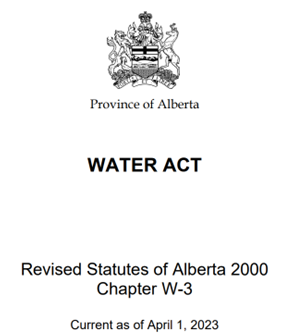This mitigation option is aimed at re-managing Alberta’s headwaters and river systems to further protect river basins and water users. To achieve re-management of a river basin, the past, present and future uses of a river must be considered. Identifying the uses and functioning of a river system contributes to more contextual information of the impact and importance of overall water systems. Re-managing headwaters and river systems encourages environmental, social and economic integration that considers all river users and uses [1].
River re-management helps to understand flooding, its impacts on different river users, and how users can play a role in the event of a flood. This mitigation approach provides a model for river management that accounts for the needs of different water users and the environment. Therefore, in the event of a flood, river re-management provides opportunities for river systems to be better managed and for improved response mechanisms to be implemented [2].
In Alberta, river re-management efforts are underway with the Bow River Project and data-oriented Bow River Operational Model (BROM). This project was designed to explore options for re-managing the Bow River system from the headwaters to confluence. As a result, the needs of Bow River users have been well-documented and specific issues have been addressed. Numerous government documents use data and information from this project to inform policies such as the Land-Use Framework, Water for Life Strategy and Calgary Metropolitan Plan [3]. Applications and simulations of the BROM model have indicated that the Bow River system should be managed differently to make room for the growth of economic, social and environmental goals in the region. Currently BROM is modeling all proposed flood mitigation options.
Re-managing water systems is a responsibility of all levels of government and communities. Individuals have a role to play by respecting water systems and doing their part to keep rivers clean and healthy. Communities can provide information on water systems as they relate to specific areas and localities. For example, the Hillhurst-Sunnyside Community Association in Calgary has created a local flood task force to not only aid in the post-flood recovery process, but also ensure that proper river management is being pursued to address flooding [4].
At the provincial level of government, re-managing water systems takes a higher level approach with policies such as the Water for Life Strategy, Land-Use Framework and specific policies including the eight river management frameworks for specific watersheds [5]. These policies are responsible for overseeing overall watershed health by regulating activities that take place on and around water systems.
Because no two water systems are ever alike, it is important for re-management policies to be aimed at specific watersheds rather than apply broadly. In Alberta, water re-management policies do account for differences between jurisdictions given their diversity. Currently, there are eight different river management frameworks in Alberta. Each management framework is aimed at the specific needs and concerns of each watershed. For example, the Industrial Heartland Water Management Framework [6] addresses the section of the North Saskatchewan River that is directly influenced by industry and local municipalities while the South Saskatchewan River Basin Approved Water Management Plan [7] addresses water quantity concerns and meeting environmental protection expectations.
Policies aimed at re-managing water systems are prevalent across Alberta and cover all watersheds. While the goal of re-managing water systems is a large one, specific concerns and locations must be addressed at the grassroots level to be accurately managed. These policies are only applicable within the Province of Alberta.
In Alberta, the Water Act is enforceable legislation that relates to water management. As it relates to river management, the Water Act allows for water management plans to be developed to address local issues and for flexible water management in areas with fully allocated water licenses by allowing license transfers [8]. Enforcement orders can be handed to individuals who contravene the Act which, can cancel water licenses or prevent further construction or use of a water license. Some of the most severe offenses can result in criminal charges.

Re-managing water systems has a positive impact on the surrounding environment and watershed by utilizing a cumulative effects perspective to determine overall ecosystem and watershed health. Specific information about water systems in Alberta helps to inform the overall goal of ensuring secure and good quality water resources for the future.
Yes, remanaging water systems would address drought conditions. Understanding specific water systems and how they function is important to further developments and strategies aimed at managing water resources in times of flooding and in times of drought.
We provide Canadian educational resources on water practices to promote conservation and sustainability. Our team crafts current and relevant content, while encouraging feedback and engagement.
The Canada WaterPortal is a registered charity, #807121876RR0001
We recognize and respect the sovereignty of the Indigenous Peoples and communities on whose land our work takes place.
© 2025 All Rights Reserved.